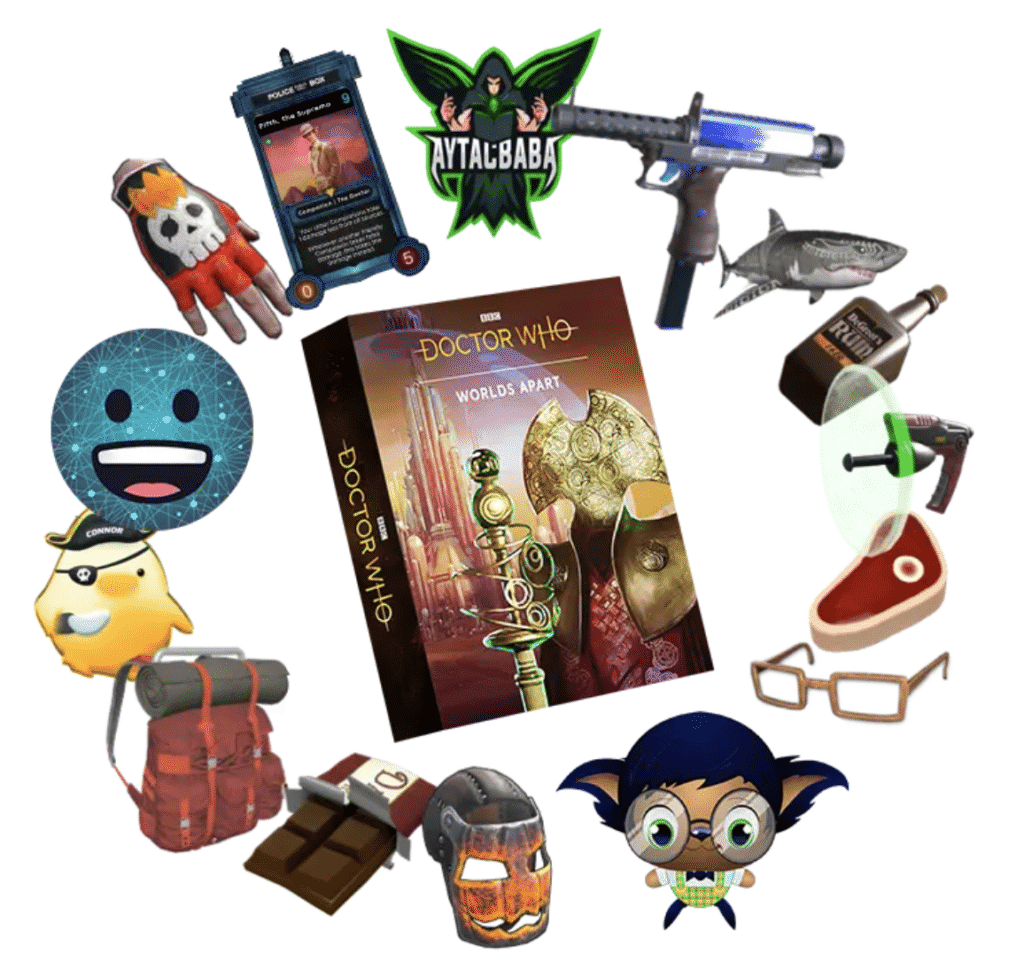– an interview in two parts with the co-founder of Reality Gaming Group, Tony Pearce
You might think that the gaming community immediately would embrace new technology like NFT and enjoy the fact that NFTs enable them to take ownership of their in-game items. However, this has not been the case so far to a large extent. On the contrary, several NFT-related games have been met with severe scepticism and a rather heavy bashing by large groups in the gaming community.
Typically, the gaming producers launching NFT games are accused of harming the environment, for promotion of scams, and for selling out and being greedy. In this second part of our interview with Tony Pearce, we ask him for his views on these accusations.
Click to read PART I
By Michael Juul Rugaard & Kristian T. Sørensen, The Tokenizer
The Tokenizer (TT): Let’s step back a bit and take a closer look at the phenomenon of NFTs and especially in relation to gaming. In your opinion, what is the fundamental raison d’etre for NFTs in gaming? Is the ownership of a digital sword in a game really important?
Tony Pearce (TP): NFTs enable new types of gameplay and introduce games to a new type of player. Provable, immutable ownership is a powerful technological tool that can lead to a completely different type of experience.
The most obvious and simple example is how we use NFTs in our trading card game, Doctor Who: Worlds Apart. Like many other thousands of similar titles, you can buy card packs for the game. Unlike any of those other games, our cards are NFTs. That means players can sell them on a digital marketplace, which people have been doing for decades with physical games. But the most important thing is that players can take those cards ANYWHERE and sell and display them in the way they choose.
Could we run our marketplace as a completely walled garden without the use of NFT technology? Sure. Would it really be true ownership of a digital item? No.
In the longer term, more open digital ownership could lead to cross-developer and publisher products that allow players to trade items between games and properties and continue to use items they own long after the lifecycle of the game.
TT: There’s been a lot of discussion around energy consumption in relation to the minting of NFTs and NFT transactions. Why introduce an environmental problem in an industry like gaming that has functioned perfectly okay for decades without NFTs?

TP: I would challenge both the idea that there is an environmental problem inherent to NFTs and that the games industry has functioned perfectly in this regard.
The environmental impact of NFTs is certainly real, which is why every project we make seeks innovative and novel ways to address that. The reality is every action we take with any digital products, including regular video games, has an energy cost. There’s a tremendous energy cost associated with streaming video, an activity the games industry has been massively responsible for growing. There’s a huge cost to the planet in producing console and gaming hardware using finite resources like lithium. There’s the cost of shipping that hardware and physical games across the world. Nothing exists in a vacuum.
NFTs have taken a bashing due to the relative cost of Bitcoin and Ethereum Proof-of-Work systems. Even Ethereum is phasing this out, but while we wait for that process to be completed, companies like ours aren’t simply static observers. We’re developing sidechains to handle some of the grunt work away from the mainnet on our own servers, which are already powered using renewable energy. We also look at different chains and work with charities that offset the carbon cost we can’t avoid.
TT: It seems as if parts of the gaming community don’t like the idea of NFTs connected to games. Is the main reason for this resistance from some groups the environmental concern? Or could there be other equally important reasons?
TP: Environmental concern is one of those reasons, but even when companies do take real steps to address those concerns, there’s still a lot of negativity when you compare it with pretty much any other sector where brands are utilizing NFTs.
There are a lot of valid and addressable concerns for the audience. Gamers have always been incredibly vocal. Look at how some game publishers often get voted as the worst companies in America. These companies produce consistently highly rated, hugely popular titles yet often beat financial institutions, fossil fuel companies and more to the top. Why? It’s partly employment practices, but it’s far more often that the gamer community simply doesn’t like that these firms acquire and often shelve beloved franchises or take them in a different direction.
NFTs, if nothing else, represent a change in direction for any games brand. The gamer community has been through this many times before: social games, mobile games, freemium, DLC and MTX. They see NFT as yet another part of this movement. This then fuels the perception that a company is being too commercially aggressive or selling out. Of course, one thing that’s rarely mentioned in these conversations is just how expensive making games has become. The Triple-A industry is barely sustaining itself on game sales, which is why we’ve seen a move to new models like live service in recent years. Adjusted for inflation, a new Triple-A game at launch is less expensive than ten years ago, despite games costing significantly more money to make. That’s why developers and publishers are looking for additional revenue streams.
The problem again is perception: Gamers don’t see an NFT offering as a way for a publisher to offset costs to make more of the games they love; they see them as destroying those games with a project that’s ‘just a commercial cash grab’, regardless of value, regardless of sustainability.

What’s strange is that NFTs actually give a benefit to the player. 99% of digital games are free to play, and the games company makes money by selling the user in-game assets. Fortnite made over $5 billion last year selling in-game assets to its players. However, when you buy these assets, you actually own nothing; you simply have a licence to use this item inside the game. You can’t sell it when you have finished the game; you can’t use it in another game. If I own it, I should be able to do what I want with it. Imagine if the games company went bust or turned off its servers – you would lose everything you bought. With NFTs, this can not happen, they are logged on a decentralised database (the blockchain), and you own them forever. This is a massive game-changer for players and surely something you imagine most players would want.
TT: Could anybody have a hidden agenda here? Could it be the case that some NFT pushback is actually orchestrated by some of the traditional gaming companies that don’t want NFT to disrupt their current business model?
TP: Could some of the resistance towards NFTs stem from the simple fact that people fear that NFTs, to a large extent, are just scams?
Absolutely. There have been some high profile rug pulls this year with projects like the Squid Game coin. These do not help perception. This is why brands need to be incredibly careful and enter the NFT market with legitimate companies with history, experience and pedigree in the space. It’s why we need to keep people and teams front and centre and put names, faces and experiences in front of audiences.
Again, this is nothing new for games. Plenty of games have rug pulled players on Early Access or Kickstarter. This is all about education, teaching audiences what to look out for and what makes a project worthwhile or not.
TT: Could it be that people see NFTs as a sign of greed? There is little doubt that a lot of NFT issuers these days are just trying to make a quick buck on something which is fundamentally worthless? Do you really believe in adding value to the community by using NFTs?
TP: We’ve touched on this idea of ‘greed’, so let’s talk about worth. Our definition of “worth” is very personal. It’s also highly dependent on personal circumstance, wealth, the where you live. Look at the difference in the perception of F2P games by Western audiences versus Asian ones. The vast majority of gamers in China see nothing wrong with pay to win mechanics at all, while the majority of Western gamers hate them with a passion. That doesn’t mean one side is right or wrong; it means you have to understand your audience.
Many people would say all video games are fundamentally worthless, right? That doesn’t mean they are, but there are billions of people who see them as a waste of time. Those people aren’t the audience for a video game company, and people who see NFTs as worthless aren’t the audience for an NFT company.
People have focused on pictures and PFPs because that’s the easiest, most reductive argument. They have no worth because pictures have no intrinsic value. It’s easy then to make the ‘right clicking’ argument, where you claim NFTs are worth nothing because they can be copied. Ignoring the fact that entire video games can also be right-click downloaded, the whole argument misses the point: strong NFT projects are about far more than that. They can be about creating a whole new community of people engaged in your brand. A members club. An exclusive social platform that’s owned by you, not by Twitter or Meta, governance, DAOs and many other things.
TT: Let’s assume that the environmental concern about NFTs is, in fact, a primary reason for some NFT resistance in the gaming space – and in some other spaces as well. But if that’s the case, it’s essential to differentiate between different blockchains and consensus methods – proof of work or proof of stake – since this makes a big difference in environmental impact, right?
TP: We’ve mentioned proof of work vs proof of stake. Yes, this is a big internal decision. But it’s not an easy thing to explain to a consumer. 99% of people in the world don’t know the difference between those two things and don’t need to know. The vast majority of people who would say they’ve heard of Bitcoin won’t have heard of Solana, be able to explain what the blockchain is or offer up more than one example of a layer 2 network.
Nor should they need to – when you create compelling products and underpin them with compelling environmental sustainability goals and policies, you should be able to work your business and ideas around the environment without being paralyzed by it.
The crypto world has already slowly shifted towards a more ecological and sustainable direction in 2021, but at Reality Gaming Group, we’re always eager to stay in front of the pack. As we work with global brands and products, we’ve already had a lot of experience developing strategies that fit in with, and even exceed, the Corporate Social Responsibility (CSR) and sustainability guidelines of those brands. But sustainability is more than just about ticking a checklist; it’s about making real changes that not only cover our own carbon usage but make an overall positive impact on the world we live in.
TT: So, let’s get this straight: is your company and other gaming companies using NFTs fundamentally harming the environment? If your answer is no, can you prove it?
TP: Does our company, like any other company on the planet, have an environmental impact? Yes.
Should we do everything we can to recognize and improve that impact? Absolutely.
The fact NFTs are held to such a high standard can be a challenge, but it’s also an opportunity. It’s why when we work with brands, we put this stuff front and centre. If it was important to your business before, that’s really going to be tested now. That’s where projects like our partnership with Refeed come from. Working out a carbon emission and then offsetting with a few trees is not only tired, but it also lacks vision and passion.
We tailor every project and brand we work on to a specific, unique sustainability strategy, working in partnership with charities around the world.
Click to read PART I
Read other stories: Does it matter?
Binance Announces Strategic Partnership with YG Entertainment



